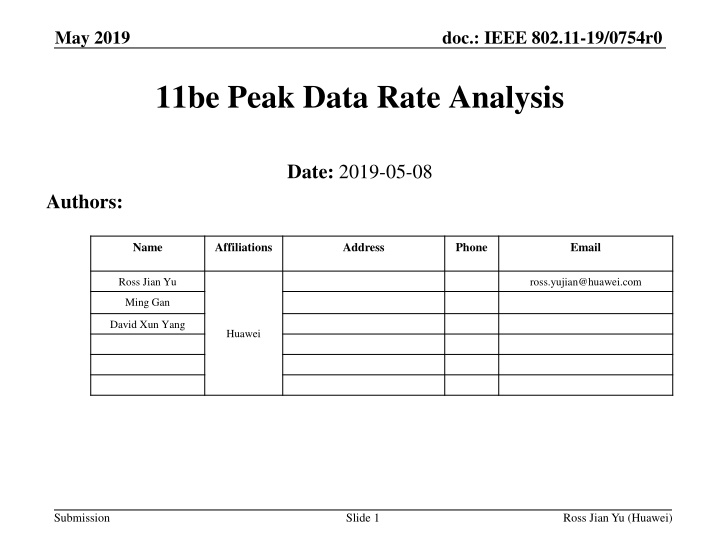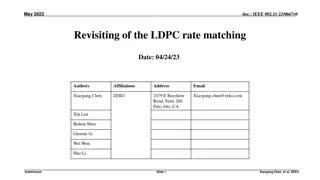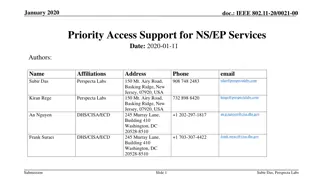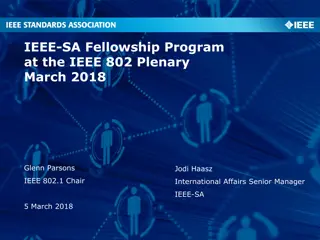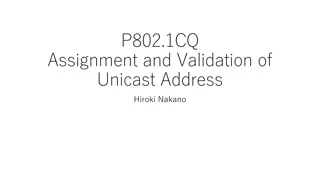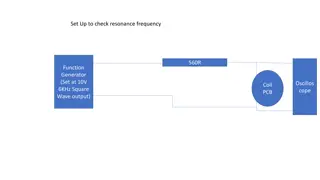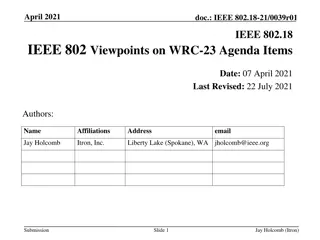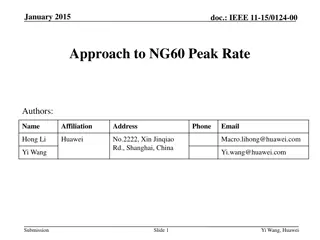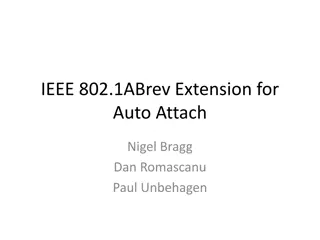IEEE 802.11-19/0754r0 Peak Data Rate Analysis
This document discusses the analysis of peak data rates in IEEE 802.11-19/0754r0, focusing on key requirements for Enhanced High Throughput (EHT) and spectrum utilization for both 5GHz and 6GHz bands. It explores the potential peak data rates achievable, considering factors like bandwidth, spatial streams, and modulation schemes.
Download Presentation

Please find below an Image/Link to download the presentation.
The content on the website is provided AS IS for your information and personal use only. It may not be sold, licensed, or shared on other websites without obtaining consent from the author.If you encounter any issues during the download, it is possible that the publisher has removed the file from their server.
You are allowed to download the files provided on this website for personal or commercial use, subject to the condition that they are used lawfully. All files are the property of their respective owners.
The content on the website is provided AS IS for your information and personal use only. It may not be sold, licensed, or shared on other websites without obtaining consent from the author.
E N D
Presentation Transcript
doc.: IEEE 802.11-19/0754r0 May 2019 11be Peak Data Rate Analysis Date: 2019-05-08 Authors: Name Affiliations Address Phone Email Ross Jian Yu ross.yujian@huawei.com Ming Gan David Xun Yang Huawei Submission Slide 1 Ross Jian Yu (Huawei)
doc.: IEEE 802.11-19/0754r0 May 2019 PAR Recap High throughput and low latency are two key requirements of EHT in the PAR of EHT[1]. The main candidate feature mentioned in the PAR [1] are: 320MHz bandwidth and more efficient utilization of non-contiguous spectrum, Multi-band/multi-channel aggregation and operation, 16 spatial streams and Multiple Input Multiple Output (MIMO) protocols enhancements, Multi-Access Point (AP) Coordination (e.g. coordinated and joint transmission), Enhanced link adaptation and retransmission protocol (e.g. Hybrid Automatic Repeat Request (HARQ)), If needed, adaptation to regulatory rules specific to 6 GHz spectrum Submission Slide 2 Ross Jian Yu (Huawei)
doc.: IEEE 802.11-19/0754r0 May 2019 Spectrum Recap For 5 GHz, two 160 MHz contiguous channels can be provided. For 6 GHz, 3 possible 320 MHz contiguous channels[NOTE], 4 possible 240MHz contiguous channels, 7 possible 160 MHz contiguous channels. Note: assume a 320 MHz contiguous channel can be formed by crossing two U-NII bands provided that the two U-NII bands are technically identical in terms of unlicensed regulatory requirements. Submission Slide 3 Ross Jian Yu (Huawei)
doc.: IEEE 802.11-19/0754r0 May 2019 Peak data rate analysis By considering the candidate feature in PAR, assuming 320 MHz, 16SS, 1024-QAM, the peak data rate is 38.4 Gbps. If 4K-QAM is further applied, the peak data rate can be 46.08 Gbps. Further taking into consideration of multi-band/multi-channel aggregation, the peak data rate can be: Link # BW configuration Peak data rate w/ 1K QAM w/ 4K QAM 2 links 320MHz + 320MHz 76.8Gbps 92.16Gbps 320MHz + 320MHz + 160MHz 96Gbps 115.2Gbps 3 links 320MHz + 320MHz + 320MHz 115.2Gbps 138.24Gbps 3 links 9 links 9*160MHz 172.8Gbps 207.36Gbps The achievable peak data rate considering 5GHz and 6GHz spectra is about 207Gbps. Further taking the complexity into consideration, a peak data rate of 100Gbps is feasible. Slide 4 Submission Ross Jian Yu (Huawei)
doc.: IEEE 802.11-19/0754r0 May 2019 Benefits and Necessity of Achieving 100Gbps From market point of view, from one generation to another, Wi-Fi should have larger data rate than cellular network of the same generation. Theoretically, 5G NR can already support 78.2 Gbps peak data rate. Cellular Wi-Fi 4G LTE-A vs 11ac Peak data rate 1Gbps 6.9 Gbps Peak data rate 4.89 Gbps per CC 78.2 Gbps over 16CCs (in FR1, sub 6 GHz) [2] 9.6 Gbps over 160MHz 5G NR vs 11ax BW 1.6 GHz for 16CCs 100 MHz per CC 160 MHz From application requirement point of view, in [3], for wireless VR applications, the PHY link Tput for raw stream or lightly compressed stream is >30 Gbps. For 3D ultimate immersion and lightly compressed rate, the required rate is 80.62 Gbps. Submission Slide 5 Ross Jian Yu (Huawei)
doc.: IEEE 802.11-19/0754r0 Mar 2019 Conclusion Benefits, necessity and feasibility for 11be to achieve a data rate of 100Gbps are discussed. The proposed method is good for 11be market promotion, can support VR applications for raw stream or lightly compressed stream. Submission Slide 6 Ross Jian Yu (Huawei)
doc.: IEEE 802.11-19/0754r0 May 2019 Reference [1] 1231r6 EHT draft proposed par [2] RP-182102 TR37.910 v1.0.0.docx [3] 11-18-1954-02-0eht-eht-use-case-discussion-vr-requirement-follow-up Submission Slide 7 Ross Jian Yu (Huawei)
